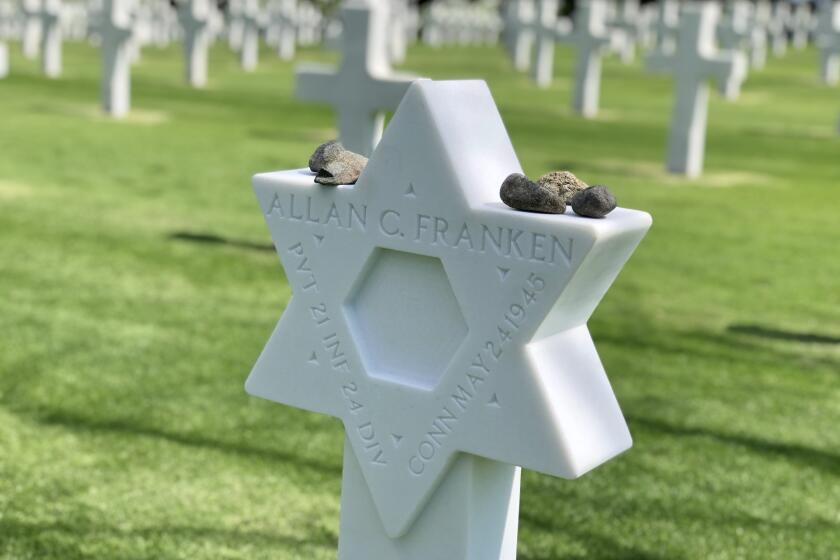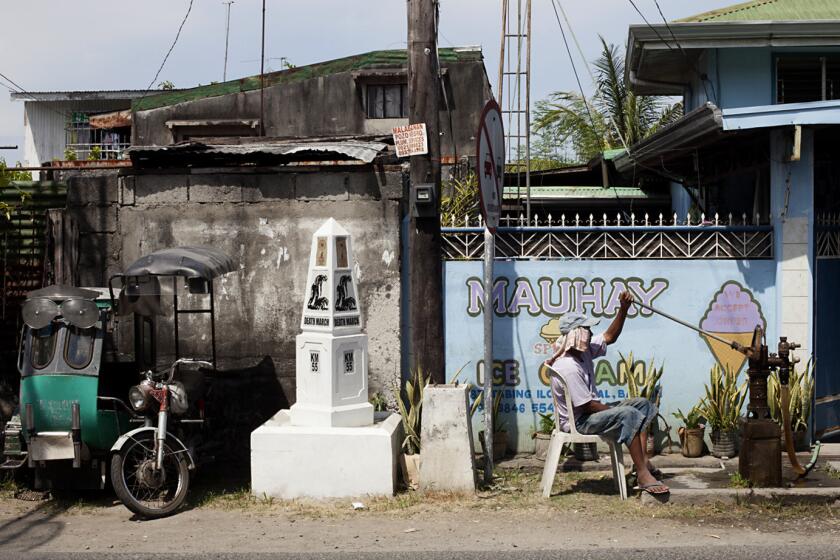This city was ravaged in WWII. Why do few remember the suffering and sacrifice?

- Share via
MANILA — The honor guard stood smartly, their swords gleaming in the morning sun. Soon, drummers beat a crisp tattoo and Marines carefully placed floral wreaths by a massive bronze statue. Finally, rifles cracked a salute and a mournful taps echoed across the old walled city known as Intramuros.
Tucked under tropical trees on a quiet corner plaza, the ceremony marked the 78th anniversary of one of the most savage — but least known — clashes of World War II, the battle to liberate Manila in 1945. In addition to 1,000 American and 16,000 Japanese combatants, at least 100,000 unarmed Filipino civilians were killed — 1 in 10 Manila residents.
Many were massacred in atrocities by Japanese troops, but many also were pulverized by U.S. artillery barrages. Countless others were maimed, impoverished and traumatized.
Much of the graceful city was turned to rubble. Large parts of its rich cultural heritage — archives of the Spanish colonial era, records from the Philippine revolution, birth and death certificates, ornate churches, grand libraries and treasured art — were obliterated. Only Warsaw suffered more among Allied capitals in the war.
“We had our own holocaust here,” Mike Alcazaren, a Philippine documentary maker who attended the Feb. 18 ceremony, told me. “And no one knows about it. It’s very sad.”
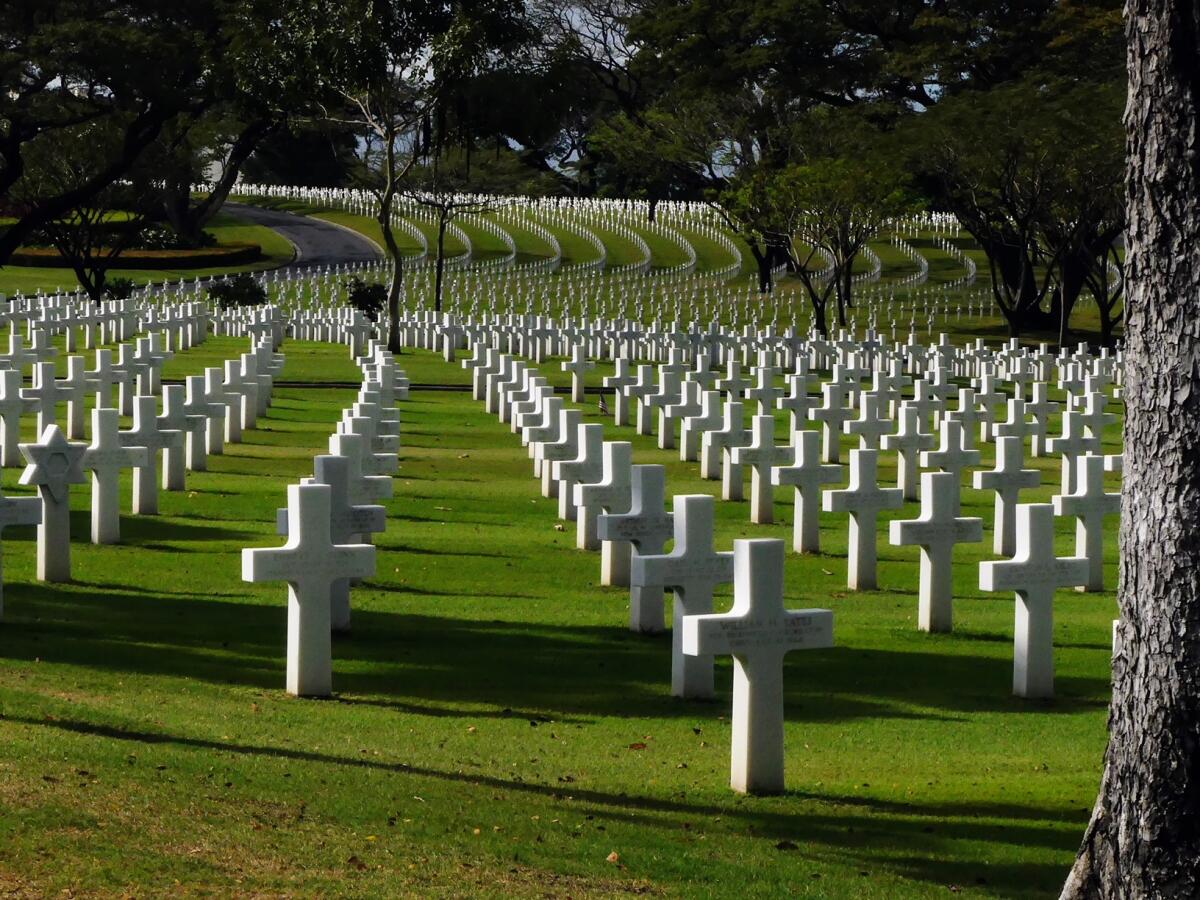
That grim historical gap is what drew me to Intramuros during a visit this year to the Philippines. I was The Times’ Manila bureau chief from 1989 to 1993, and I had read haunting accounts of the heroism and horrors of the Pacific war. I even wrote of WWII relics that rust in peace on Guadalcanal and elsewhere.
Yet I knew almost nothing about the monthlong battle that had devastated the heart of the American colony. History books barely mentioned it. Schools didn’t teach it. Monuments didn’t honor it. I wanted to find out why.
What accounted for the collective amnesia? Only about 30 people attended the ceremony at Intramuros. Was it best to leave the past in the past? And as a new war rages in Ukraine, are there lessons to be learned — to not let those horrors also be forgotten?
I soon found a small group of survivors, historians, hobbyists and others determined to honor the unimaginable sacrifice and loss here. With their help I visited memorials, markers and museums, as well as more grisly sites. Some opened only in recent years as a result of their work.
After the memorial ceremony, I walked into a dim, dank dungeon-like vault in the immense stone walls of Intramuros that opened to the public only in 2020. In 1945 Japanese troops locked about 600 Philippine prisoners inside with no food, no water, and left them to die.
Gritty black-and-white photos tacked to the walls show the ghastly conditions American soldiers found when they pried open the thick iron doors.
“I put them up,” said Desiree Benipayo, an author and businesswoman who runs the nonprofit Philippine World War II Memorial Foundation. “People need to see what happened. People need to know.”
But the reckoning is fraught. Japan is the largest aid donor to the Philippine government and a major source of investment. Tokyo has never formally apologized for the atrocities, and Philippine officials seem wary of giving offense.
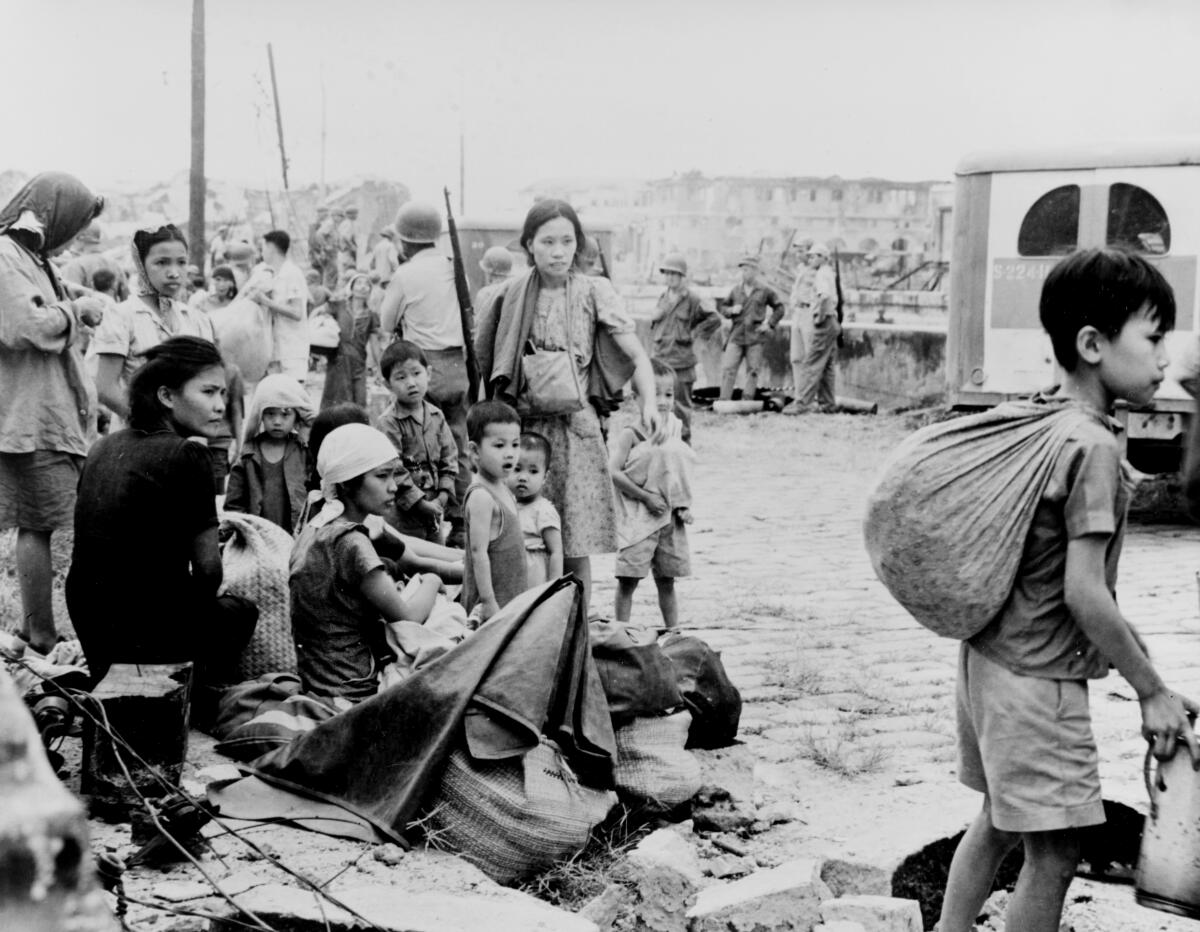
In 2017, the National Historical Commission erected a bronze statue on the Manila waterfront to honor “comfort women,” the euphemism for those forced to serve as sex slaves for Japanese troops. But it was pulled down after a Japanese minister complained to Rodrigo Duterte, then the Philippine president, that the statue’s appearance was “regrettable.”
I found a far different and unexpected monument in Mabalacat, north of Manila, built by local officials in 1998 to attract Japanese tourists. Behind a tall torii gate, a larger-than-life statue of a kamikaze pilot is flanked by a huge wall painted with Japan’s wartime Rising Sun flag.
Since the suicide pilots sank dozens of U.S. warships and killed thousands of Americans, I was appalled. It was, I thought, like finding a statue of Osama bin Laden in Lower Manhattan.
But I found encouraging changes too. The National WWII Museum in New Orleans, which has run tours to battlefields in Europe and the Pacific for years, sold out its first-ever tour to the Philippines in March. James Scott, who in 2018 wrote “Rampage,” a vivid history of the Battle of Manila that spurred the renewed interest — including mine — helped guide the group.
“I like to think history eventually corrects itself,” Scott told me from his home in Charleston, S.C.
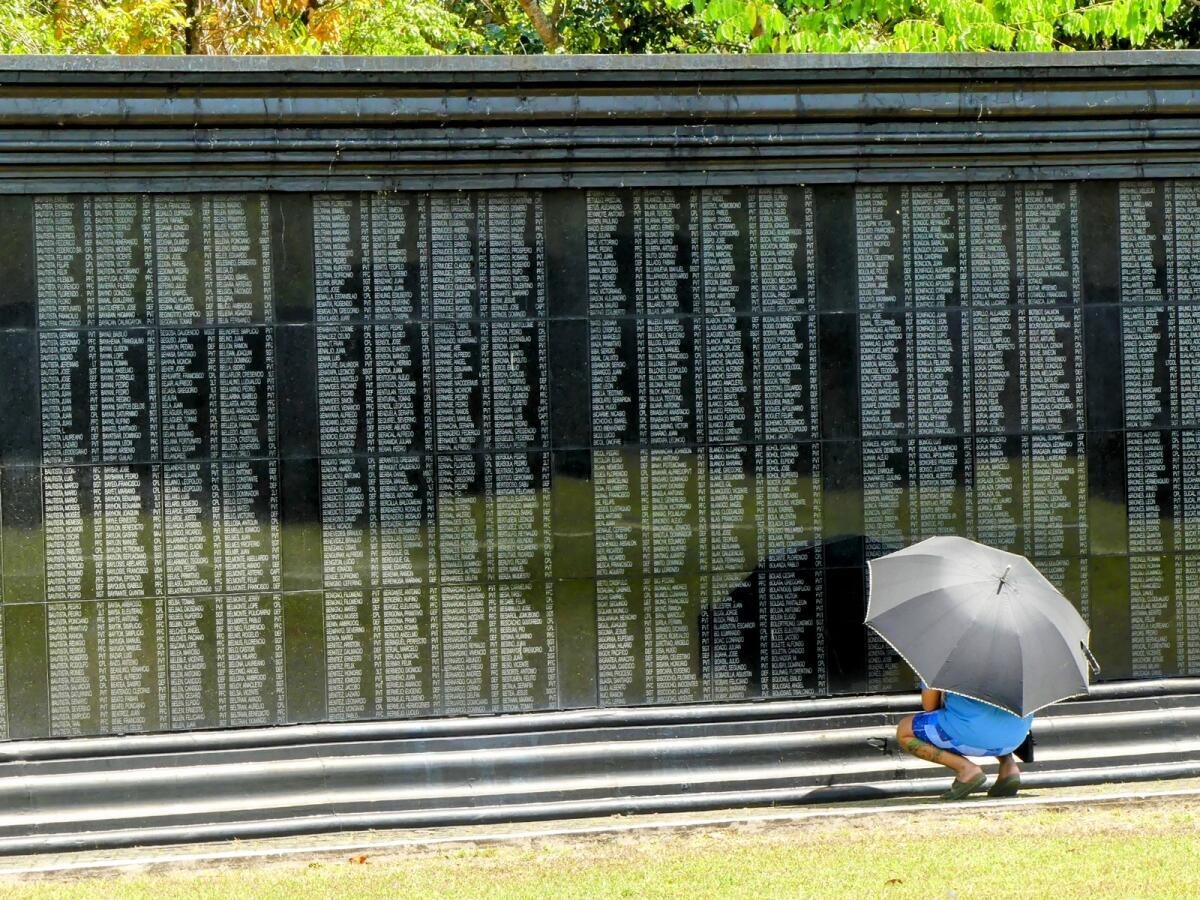
Researchers now can access an invaluable trove of war-related material at the Filipinas Heritage Library in Manila. In 2010 it acquired the Roderick Hall Collection, some 5,000 books, manuscripts, military reports, newspapers, films and audio about the war in the Philippines. I spent an afternoon there browsing some of the poignant, often painful memoirs.
“We stood in the sun for hours, many of the elderly with ankle, legs and knees swollen to almost the bursting point,” Ruth Hooper, an American teenager who was interned by the Japanese in Manila, wrote in one. Filipinos who tried to help them “were hanged by their thumbs until they died.”
I also spent a sobering morning at the Manila American Cemetery, the final resting ground for most of the Americans killed in the Pacific war. It is America’s largest military cemetery overseas, dwarfing those in Europe. Long lines of white marble headstones, 17,058 in all, climb the gentle green hills. Another 36,268 names, etched on giant stone tablets, honor those missing in action, or lost or buried at sea.
Many Jewish Americans were mistakenly buried under Latin crosses after the war. Scholars are working to correct the record -- and their gravestones.
I found Leonard Drogin, a distant relative, on one of the tablets. Military records show he was lost at sea off Saipan in March 1945. He was 23. Yet even the cemetery is changing. Thanks to DNA and other tests, several hundred sets of remains have been identified in recent years and given new headstones or repatriated to families. Several graves were being disinterred during my visit.
And in 2019, the American Battle Monuments Commission, which runs the cemetery, opened a visitor center with elaborate exhibits, including one on the Battle of Manila.
“The challenge is to keep our mission relevant,” Vincente Lim IV, the director and great-grandson of a famed Philippine general who was executed by the Japanese, told me. “In addition to a place of mourning, it is now a place of education.”
At a Memorial Day observance held at the cemetery on Sunday, U.S. Ambassador to the Philippines MaryKay Carlson said, “We are reminded that freedom comes at a great price and that it is a cherished shared value worth fighting and dying for,” according to the Manila Times.
America’s war began when the Japanese attacked Pearl Harbor in Hawaii early on Dec. 7, 1941. Hours later, their aircraft destroyed nearly every U.S. warplane in the Philippines, most still sitting on runways.
When Japanese ground forces invaded the Philippines later that month, Gen. Douglas MacArthur, commander of U.S. Army Forces in the Far East, ordered U.S. and Philippine troops to evacuate Manila and to withdraw to the jungle-clad Bataan Peninsula and nearby island fortress on Corregidor.
MacArthur’s forces vastly outnumbered the invaders. But in the rush to retreat, his army didn’t bring enough food or supplies.
On April 9, 1942, about 78,000 gaunt and suffering American and Philippine troops laid down their arms, the largest surrender in U.S. military history. Thousands died or were killed, often beheaded, during the brutal Bataan Death March, a 60-mile trek to a makeshift prison camp at Capas. Thousands more fell to disease, hunger and abuse in the hellish camp.
Before the surrender, MacArthur had escaped to Australia, where he vowed to “return” to the Philippines. It took the army nearly three years of bitter fighting in torrid jungles, fetid swamps and on jagged coral islands, but he finally waded back ashore on Leyte Island in October 1944.
On Feb. 3, 1945, U.S. troops rescued 3,800 emaciated American and British civilians who had been interned at Santo Tomas University in Manila. In response, Rear Adm. Sanji Iwabuchi’s troops started to systematically set fire to Manila’s residential and business districts, and to torture and slaughter civilians.
Over the next month, Japanese sailors and marines raped and mutilated countless women. Some tossed babies in the air to spear them on bayonets, according to testimony at subsequent war crimes trials.
At one point, Japanese marines cut a hole in the second floor of a house, led scores of Philippine captives upstairs, forced them to kneel at the edge, and beheaded them one by one.
I asked Ricardo T. Jose, the country’s foremost expert on WWII and professor emeritus of history at the University of Philippines-Diliman, about the torture, beheadings and rape.
“There’s lots of talk that the Japanese went mad, went berserk,” he told me. “But the orders were very clear. Round people up, use as few bullets as possible, and kill them all.”
In one well-documented case, teenager Anna Maria Aguilella was stabbed 16 times after her family took refuge in the Spanish Consulate. She somehow survived although her parents and siblings were killed.

“The Japanese entered, they lined us up, children in front and the elderly behind, and they bayoneted all of us,” she recalled in 2020, according to El Pais, a Spanish newspaper. “They thought I was dead, after 16 injuries, with one of them, the most serious, to the head. But it was not my time, and I survived two days among the dead.”
Thousands of civilians also were killed by friendly fire as American troops used flamethrowers, tanks and huge “Long Tom” howitzers against entrenched Japanese forces. Partly as a result, many Filipinos later blamed U.S. forces for what they considered the unnecessary destruction of their city.
“American shelling probably killed 30 to 40% of the people, including my grandmother, my sister and aunt,” said José Miguel Cabarrús, president of Memorare Manila 1945, a group founded by survivors and their descendants. “They were lying in a bed and an American shell hit the house. But the Americans didn’t torture, behead and rape people like the Japanese.”
So why was it all quickly forgotten?
“It was such a traumatic event no one wanted to remember it,” Jose, the historian, told me. “Even getting people to talk about it decades later was difficult. Also, it was mainly unknown civilians who suffered. So there was no organized group, like the military has, to honor them. It became a black hole.”
Unlike the self-named “battling bastards” of Bataan and the doomed garrison on Corregidor, Alamo-like symbols of defiance that helped rally anxious Americans back home and spawned stirring Hollywood films, the nightmare in Manila got little coverage in the U.S. media.
One reason is MacArthur declared on the third day that victory was “imminent,” even though the battle had barely begun. A week later, even as artillery duels and fires raged in the once-elegant city, a headline in Newsweek declared, “Prize of the Pacific, Manila, Fell to MacArthur like Ripened Plum.”
Censors on MacArthur’s staff prevented war correspondents from revealing the harsh truth, and editors back home lost interest.
The carnage also was overshadowed by the tumble of titanic events that followed — murderous combat on the Japanese home islands of Iwo Jima and Okinawa, the American firebombing that leveled much of Tokyo and dozens of other Japanese cities, and then the atomic bombings of Hiroshima and Nagasaki that ended the war in August 1945.
Afterward, the emerging Cold War alliance of Japan and the U.S. against the Soviet Union “airbrushed many of the horrors from the history books,” said John Labella, head of the Filipinas Heritage Library.
“We know that during the fighting a mother smothered her crying infant with a pillow lest the Japanese discover her family hiding and kill them all,” he said. “In a way, the Cold War smothered the Battle of Manila.”

The act of remembering then falls to people like Rhonie C. Dela Cruz. He has spent 20 years scouring the rocky crags and jungled hills around Bamban, north of Manila, and recovered still-loaded machine guns and other artifacts. Two long-tail macaques greet visitors to the private museum he runs at his home, but he gets few visitors and little support.
Dela Cruz led me up steep, slippery trails and into three deep caves that the Japanese carved out of the volcanic rock. U.S. bombing collapsed dozens of caverns and tunnels, but he has found and opened five. Two still had remains of Japanese soldiers entombed within.
“I’m just an ordinary guy,” Dela Cruz said as we explored a winding tunnel that, according to a small Japanese shrine at the entrance, was once the kamikaze commander’s bunker. “I do this for my uncles, who fought the Japanese here, and my grandfather, who was beheaded by them. It’s a shame. So much history, and no one remembers it.”

More to Read
Sign up for Essential California
The most important California stories and recommendations in your inbox every morning.
You may occasionally receive promotional content from the Los Angeles Times.
